Talk by Rudy Rucker for Internet Festival 2019 in Pisa, Italy, Friday, October 11, 2019, 15:00 - 17:00, CENTRO CONGRESSI LE BENEDETTINE, Aula B, With Ran Zhang and Daniele Brolli.
Where I’m From
I grew up in Louisville, Kentucky during the 1950s and 60s. I read a lot of science fiction. And I was fascinated by the Beat writers Jack Kerouac and William Burroughs. I wanted to be a novelist.
In 1963, I left Louisville, and went to college. I wanted to be a writer, but I majored in Mathematics. I didn’t like the English Lit classes. I figured I’d learn to write fiction on my own.
After Swarthmore, I married my college girlfriend, Sylvia. I got a Ph. D. in mathematics. I went on to have a fairly good career as a writer. I’ve published about forty books. I’ve written popular science books about infinity, about the fourth dimension, and and about the nature of computation. Many of my books are science fiction novels.
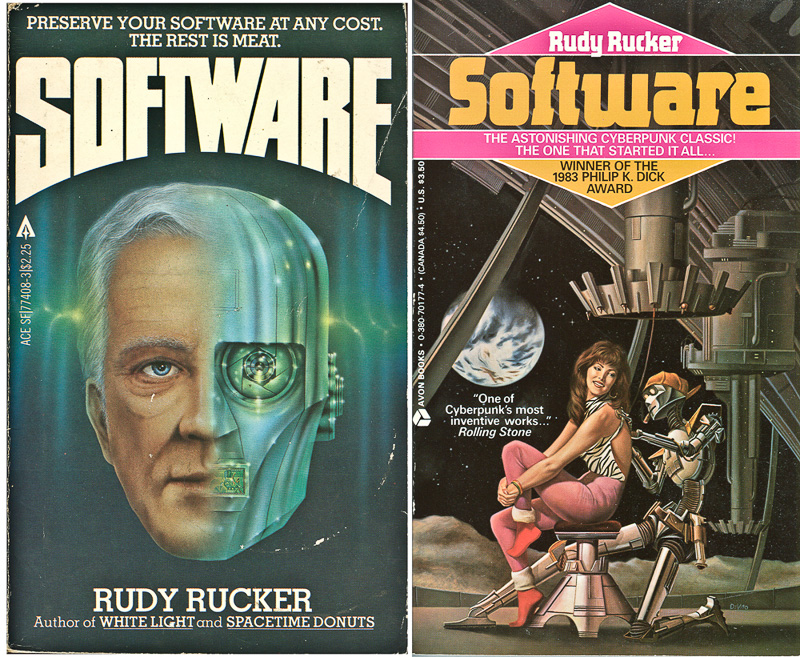
My best-known novel is Software, written in 1980. It was one of the earliest cyberpunk novels.
What is cyberpunk?
Simple answer: Cyberpunk = Cyber + Punk.
The cyber idea behind Software seems simple now.
- You can make a software copy of your mind and load it onto a robot.
You’ve seen this scenario in a hundred movies and TV shows. But I was the first one to write about it. In 1980, “soul as software” was an unheard of thought. Hardly anyone even knew the word “software.”
To make my Software punk, I made the brain-to-software transfer gnarly. A gang of scary-funny hillbillies extracted people’s mental software by slicing off the tops of their skulls and eating their brains with cheap steel spoons. One of the hillbillies was a robot in disguise, and his stomach analyzed the brain tissue. Did I mention that I grew up in Kentucky?
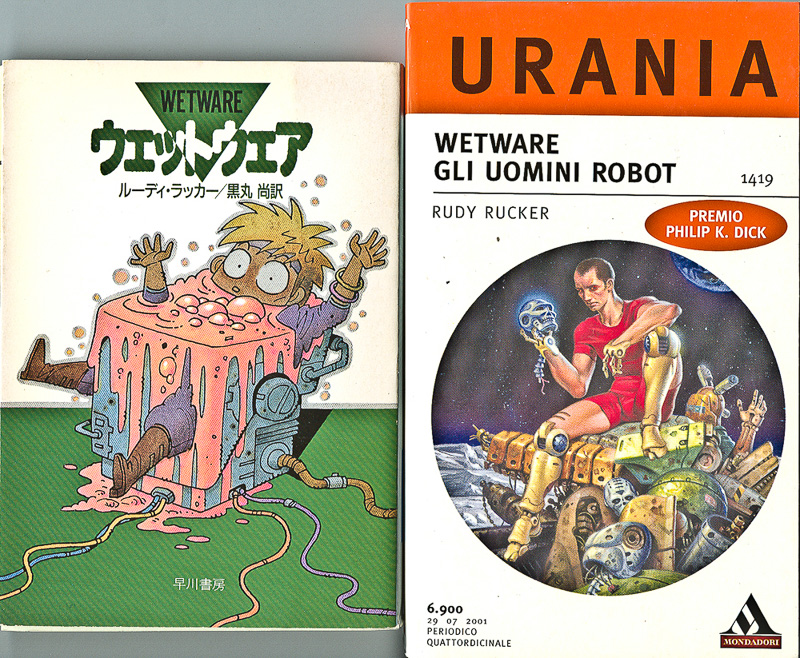
I went on to write three sequels: Software, Wetware, Freeware, and Realware. They’re collected in my Ware Tetralogy. And you can read my Complete Stories for free online. Read one of my stories before you go to sleep tonight. You’ll have interesting dreams.
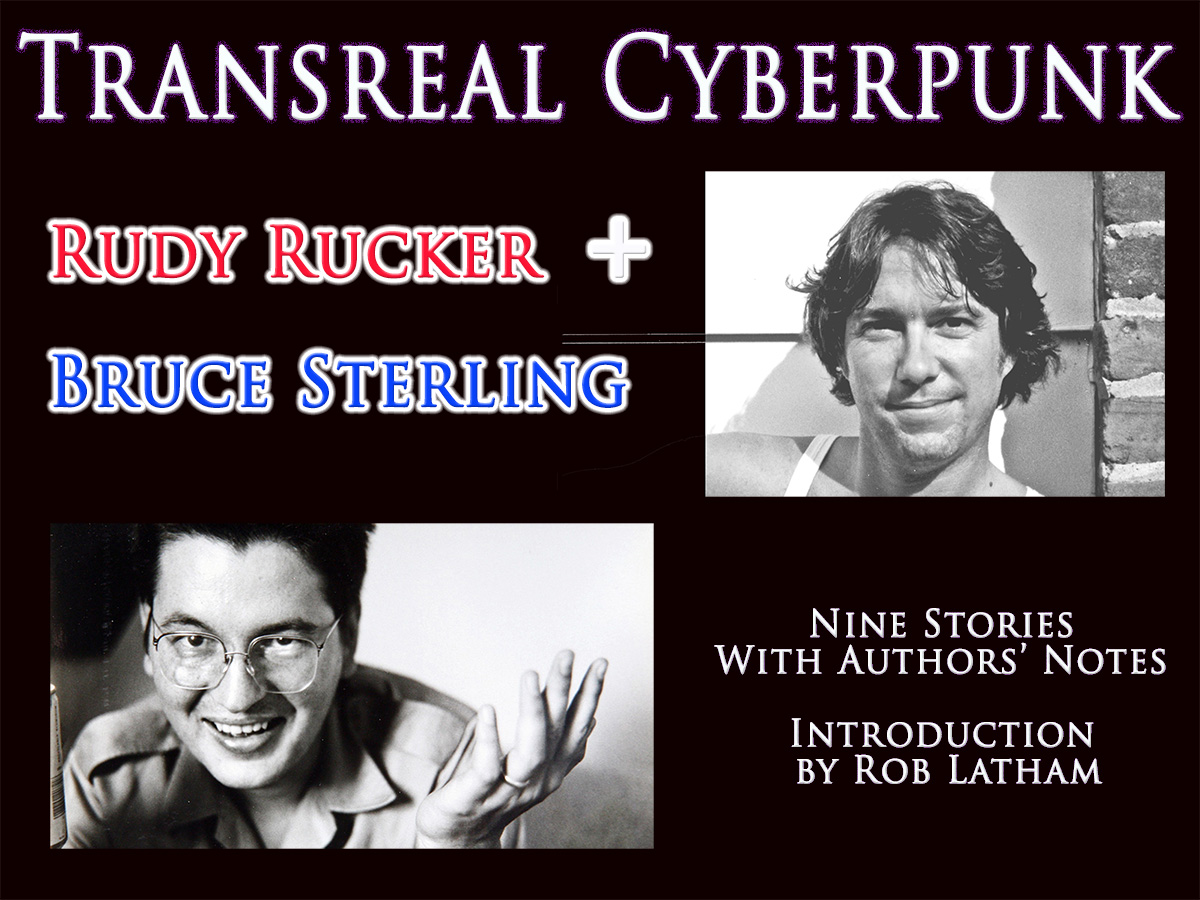
Early in my career I began collaborating with the “almost Italian” writer, Bruce Sterling. We recently published a book called Transreal Cyberpunk with nine stories that we wrote over the last thirty years.
Back to my life story. In grad school I was a hippie, in the Eighties I was a punk, and after that I settled down to being a cyberpunk. Even so, I’m a reliable family man, with three children, and five grandchildren.
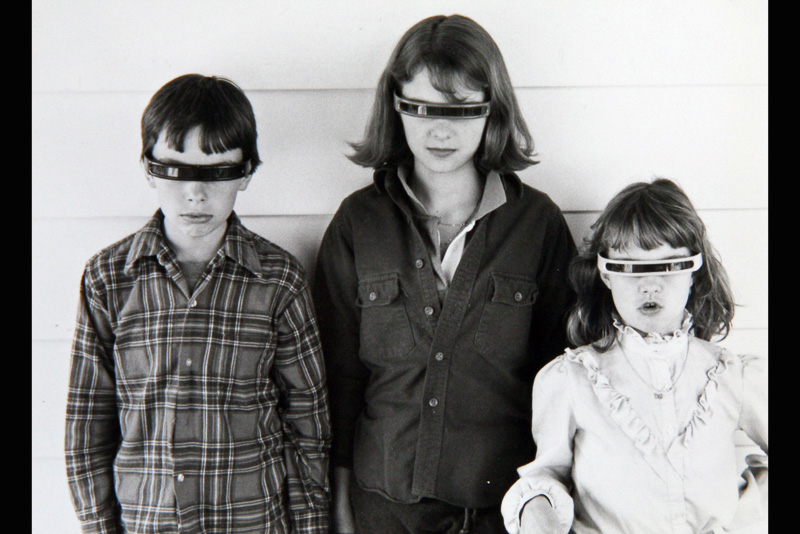
A photo of my cyberpunk children in the early 1980s.
Being a respected writer doesn’t necessarily pay very well, so for most of my life I had a day job. I was a math professor until I was forty, and then we moved to California, and I became a computer science professor at San Jose State, in Silicon Valley.
I let the chip into my heart. As well as teaching CS, I did some work as a software engineer at Autodesk. I published several programs involving cellular automata, chaos, videogames, and artificial life. You can get these for free online.
Cyber
Cyberpunk is about computers merging into our reality. Cyberpunk explores the dancing boundaries among humans, daily life, and computers. The real world is blending with the computer world.
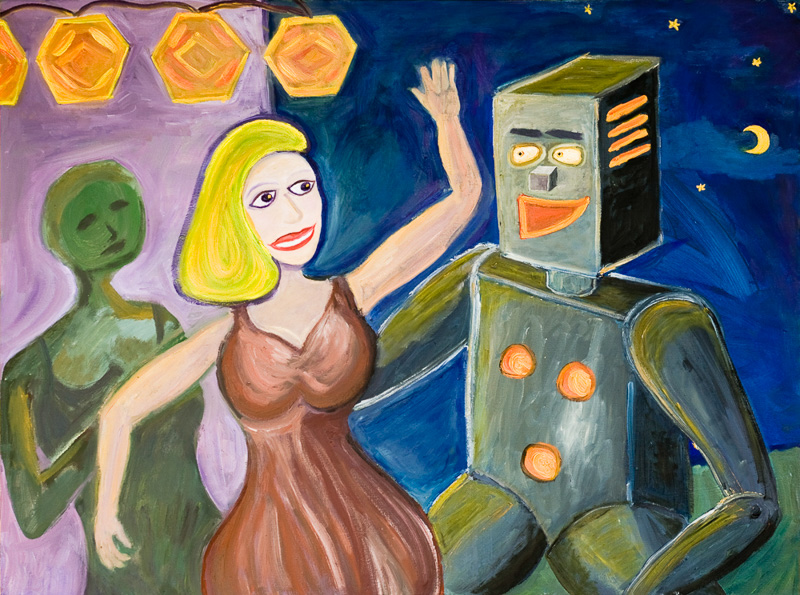
Software → People. Programs imitate us.
- Software bots emulate partial human functions, taking over our jobs.
- Hand-coding a full human-level AI is literally impossible, (proved by Alan Turing).
- But we can evolve human-level AI…using neural nets…but we won’t know how they work.
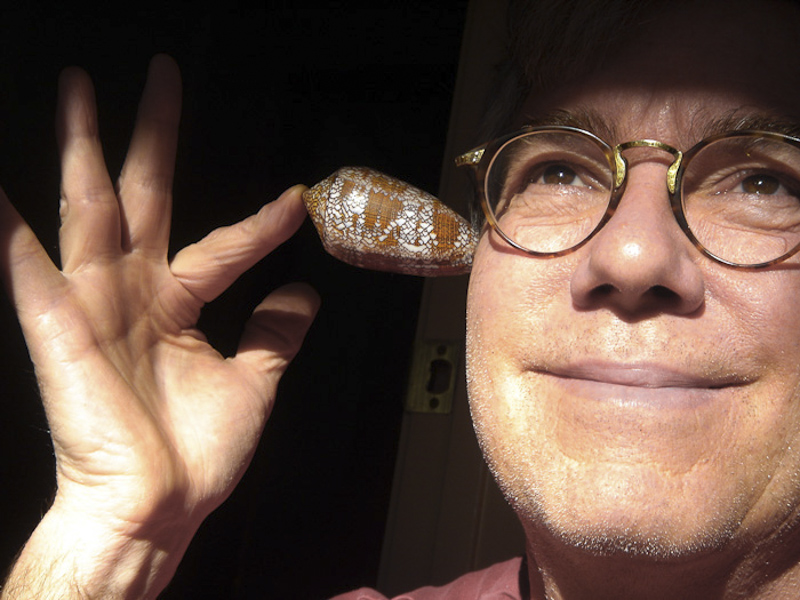
People → Software. We augment ourselves with bots and robots.
- People enhance themselves with apps on devices.
- Apps can move to biocomputing symbiotes…to wear like leeches, like the “uvvy” discussed below.
- The goal is digital immortality. Uploading into the cloud, or into an android bot, or into an animal.
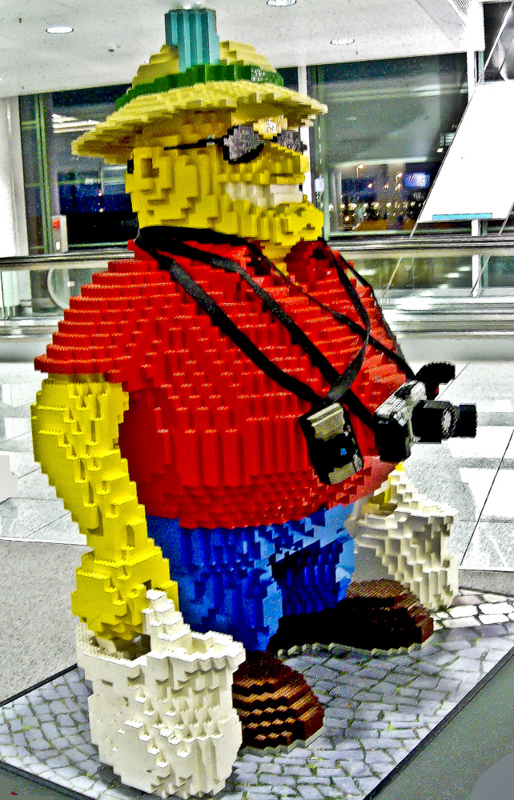
Software ↔ Reality. The cloud merges with daily life.
- Our daily world is saturated with the ubiquitous internet. Like damp sand is wet with water.
- Face to face conversations are replaced by messaging, video, and social.
- . We shop online with e-commerce.
- We use VR to emulate the world, for entertainment, for training, and for predictions.
Punk
Punk is about maintaining our individuality, our independence, and our attitude.
Computers aren’t everything. Behaving like a robot is unpleasant. It’s more fun to be human.

The VR worlds of videogames are too clean. Even their scuff marks are clean. As Bruce Sterling once said, “We cyberpunks need to get in there with our spray cans.”
The physical world is grungy and gnarly. Wherever I am, I always look for the chaos, the natural gnarl, and when I find it I feel safer.
Punk is about turning your back on conventional top-down rules. Cyberpunk film and literature breaks free of the boring old plastic, white-bread visions of the future. And folding in more of our actual, daily world.

Punk is for countercultural, decentralized politics. Like, “You’re not my boss. I’m not listening. I’m doing it my way.” In a nutshell?
Punk means give the finger and walk away.
We want to be invisible, to have privacy, and to evade central control.
Don’t get permission, just do it.
Lifebox
I have a preliminary model for full human emulation. This is called a lifebox, and I wrote about it in my tome, The Lifebox, the Seashell, and the Soul. In the next few years we’ll see lifeboxes as consumer products
A lifebox has three layers.
- Data. A large and rich data base with a person’s writings, plus videos of them, and recorded interviews.
- Search. An interactive search engine. You ask the lifebox a question, it does a search on the data, and it comes up with a relevant answer. Like Googling a website.
- AI. A veneer of AI. An evolving neural net.
You can “talk” to a dead person if you have access to an online copy of their lifebox. The lifebox remembers each user’s search history and inputs—and pieces together a semblance of a continuing conversation
When you talk to an online lifebox, it might show an animated model of the lifebox creator. Or it might just be a little talking box with no screen. Here’s two kids talking to their dead Grandpa’s lifebox. They ask rude questions.
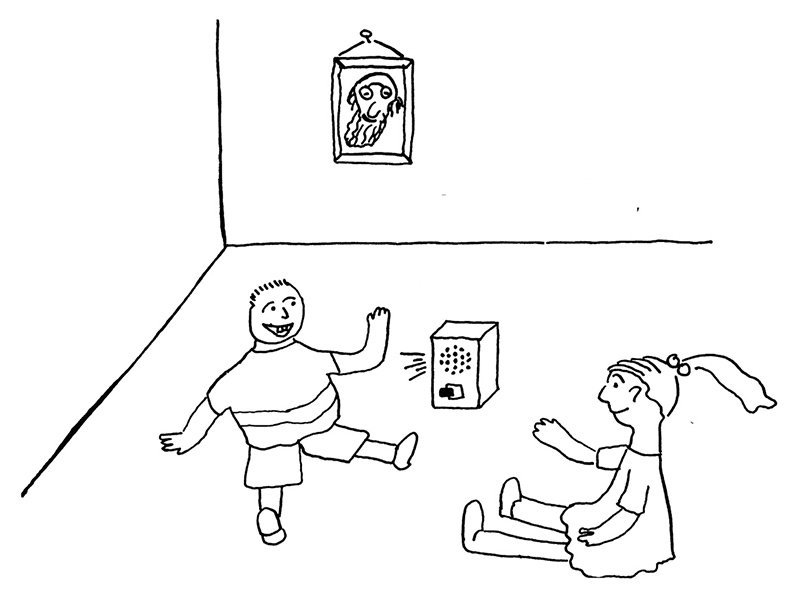
A person’s flow of thought is captured by links among the lifebox items. The links express the author’s sensibility, that is, the person’s characteristic way of jumping from one thought to the next.
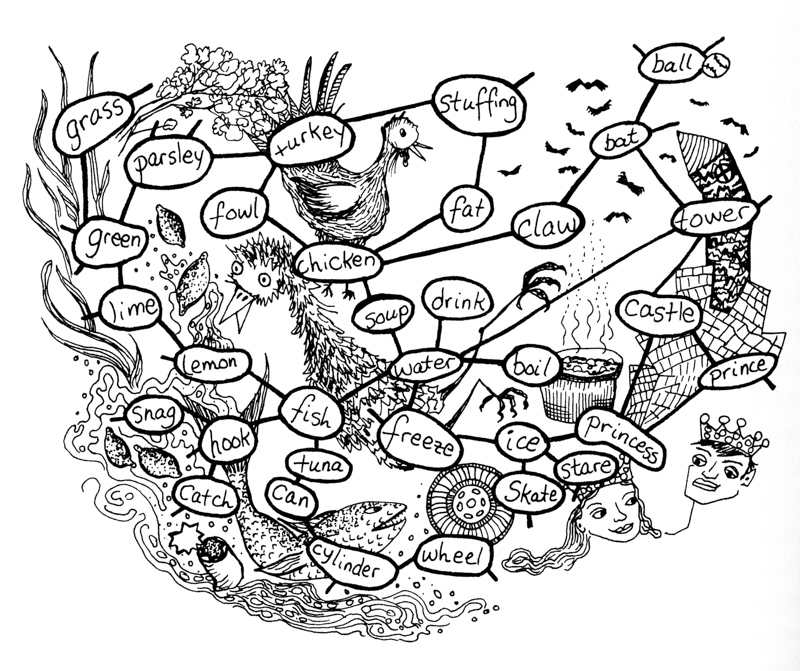
How do you create your lifebox? First you can input your writings, your emails, your social media posts, your photos, and the like.

Beyond this the lifebox can interview you, prompting you to tell it stories. The lifebox links your anecdotes via the words and phrases you use. To clarify the data structure, the lifebox asks follow-up questions.
Note that humans build mental lifeboxes of their lovers and friends. In an intimate verbal conversation, language feels as effortless as singing or dancing. The ideas flow and the minds merge. Your internal lifebox models draw on a clear sense of your partner’s history and core consciousness.
By way of enhancing traditional text and image communications, people might use lifeboxes to introduce themselves to each other. Like studying someone’s home page before meeting them.
Telepathy
Our words act as instructions for assembling thoughts. But telepathy could work differently. By way of analogy, think about three different ways you might tell a person about something you saw.
Like this cool image from San Francisco. How to share it?

- Text. Give a verbal description of the image, via voice or via message.
- Image. Show them a photo.
- Link. Give them a link to the photo on your webpage.
In showing you this post, I’m using words and bitmaps to get you to emulate my thoughts. But what if we had telepathy? I like to use the word teep for telepathy. I don’t think commercial, tech-based telepathy is very far off.
Let’s imagine a brain-wave-based cell phone. I call such a device an uvvy. An uvvy might instead be like a removable piezoplastic leech that perches on the back of a user’s neck. Or it might be a biocomputing leech.
An uvvy can read your brainwaves. and transmit the patterns to someone else.
And an uvvy can receive brainwave patterns and etch them into your own brain. You are directly experiencing each other’s thoughts.
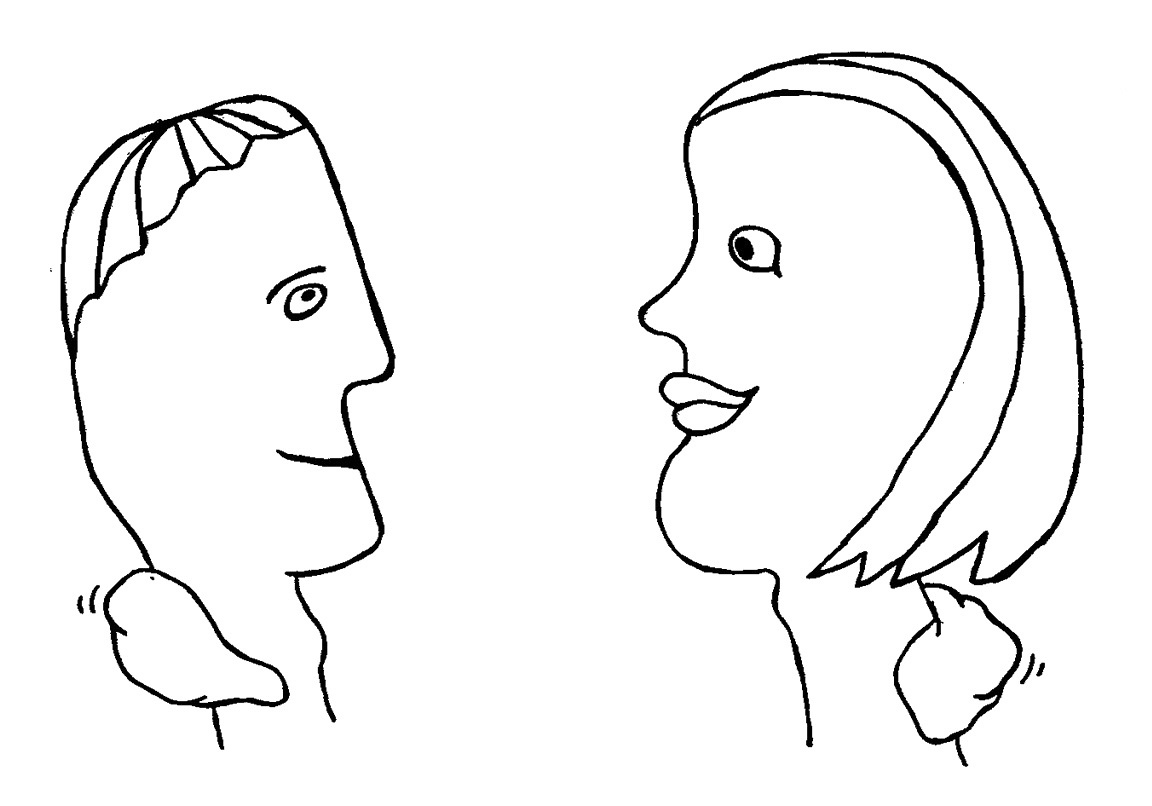
The most obvious use of an uvvy would be to use it like a videophone which also includes emotions and physical sensations. We’d use it for teep.

A possible problem with brain-link teep is that you might have trouble deciphering the intricate structures of someone else’s thoughts—seen from the inside.

Sharing lifeboxes could help make sense of another person’s internal brain links.
That is, as well as using ethereal brain-wave-type signals, you’ll want to use hyperlinks into the other user’s lifebox . The combination of the two channels can make the teep comprehensible.
Immortality
A lifebox is a software model of a person. If you have a lifebox, are you immortal?
Preserve your software, the rest is meat?

Two problems.
- Software doesn’t seem to be conscious and self-aware.
- We want to be embedded in the physical, natural world. We want sensations, and we want to be able to touch things.
It seems possible to develop a strong AI that it enjoys self-awareness. The essence may be to model one’s sense of “watching yourself watch yourself”
We might call self-conscious lifebox a ghost.
.jpg)
Where does the ghost live? You don’t want Apple, Microsoft, Google, Facebook or Lifebox, Inc., to own your ghost. You want your ghost to be a free agent.
So okay, store your lifebox ghost in a rock, let’s say it’s your tombstone.
Rocks have a lot of computational power….given that they contain an octillion particles joined in a parallel quantum computation.
That’s fine, but you also want to be running a body that can walk around and feel things. You might embody yourself as some kind of machine—an android, a drone, or even a bulldozer.
But natural bodies are where it’s at. They’re gnarly and dirty and interesting. Where there’s filth, there’s life!
If you’re pushy, you might want to take over another person’s body, or share it with them. Or you might use a fresh, tank-grown human body. Or use an animal!
Put your tombstone mind inside a dog.

I use the expression juicy ghost for a lifebox model-ghost that’s running in the body of an animal, like a human, or a dog, a bird, or an insect.
I recently wrote a subversive political story about this called “Juicy Ghost.” You can read it online in a zine called Big Echo.
What if your juicy ghost body dies? Well, you’ve stored your lifebox within the quantum computations of the rock that is your tombstone, so now you can download yourself into any fresh human or animal body that passes by.
And thus you become immortal as a series of juicy ghosts, a series of living avatars, each with sense organs, mobility, and an ability to act in the world.
And all these wonders are thanks to cyberpunk!
References
I discussed the lifebox in my futurological novel, Saucer Wisdom.
I write about the lifebox in more technical detail in my popular science book,The Lifebox, the Seashell, and the Soul>.
See also my Complete Stories , especially the stories “Soft Death” and “Juicy Ghost.”
My novel Software is part of the Ware Tetralogy.
I have a rudimentary lifebox for myself online as, “Search Rudy’s Lifebox,” at www.rudyrucker.com/blog/rudys-lifebox









October 9th, 2019 at 10:47 am
You want cyberpunk? Here goes:
Our flawed hero agrees to have a lifebox make of him. Interviews, history searches, brain scans, intrusive psych tests, and signing a contract with the lifebox corporation. But it turns out that the lifebox corporation is run by an AI with a dystopian agenda of its own. Also, our hero chats with his lifebox and finds it agreeable but somehow dissatisfying. Meanwhile a pirated version of that lifebox is made by scuzzy hackers, who include a rogue freeware AI. Our hero chats with pirated lifebox; they get on each other’s nerves, have a screaming argument, which ends with our flawed hero spluttering, “You’re me all right!” Further hilarity ensues; contract breaches, lawsuits, courtroom scenes, ending with rogue AI and pirate lifebox deleted by court order – but illegally multi-copied elsewhere – and the corporate AI exposed, bankrupted, and sold for parts.
October 15th, 2019 at 11:44 pm
On the subject of Telepathy.
I recently read a few books by Rupert Sheldrake.
Have you come across him?
His Youtube video of Telephone telepathy is very interesting.
Of course skeptics all hate him and he was banned from TED.